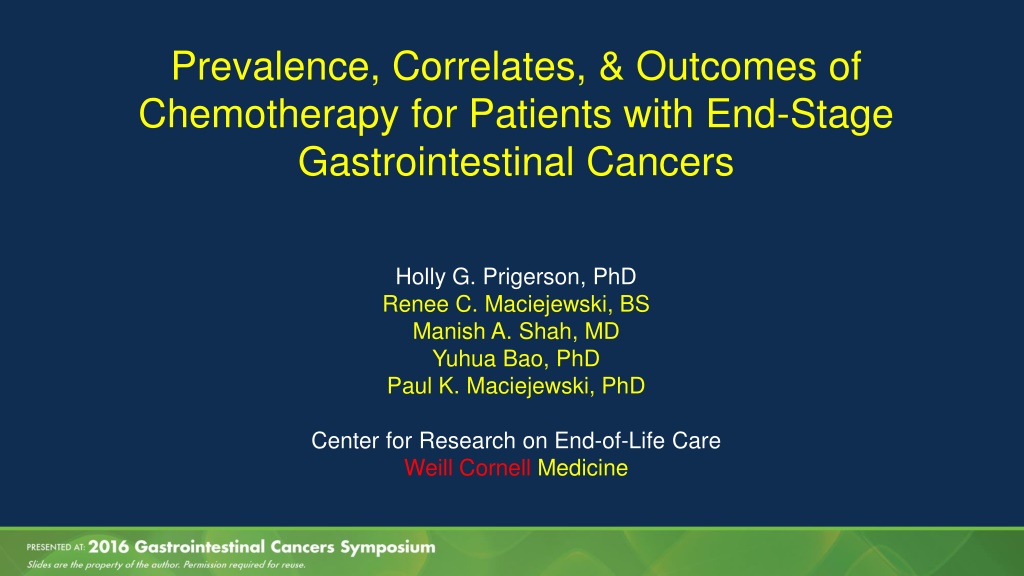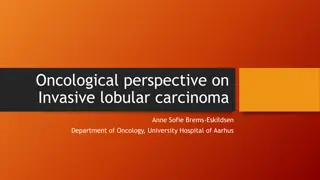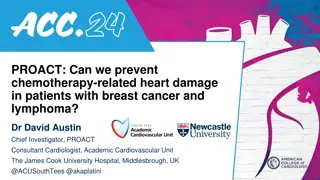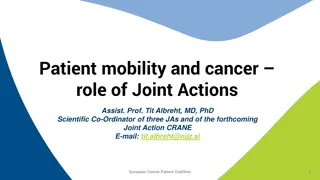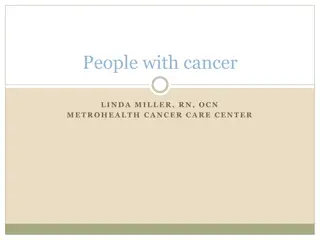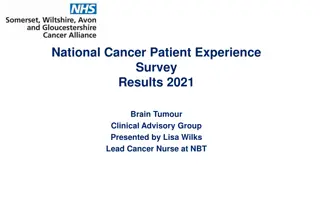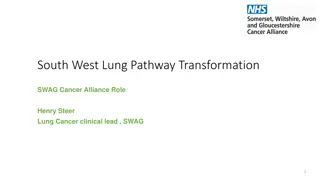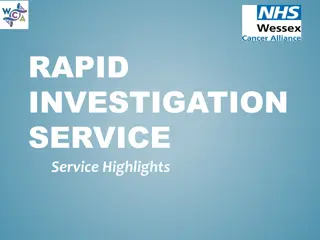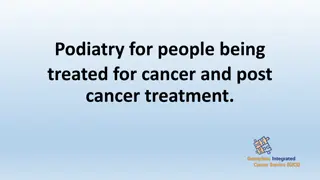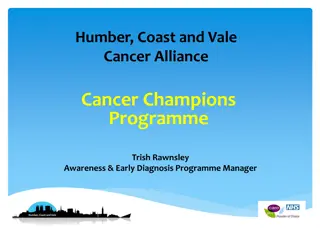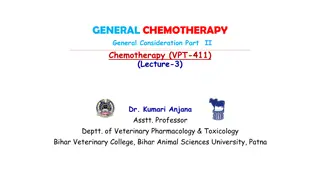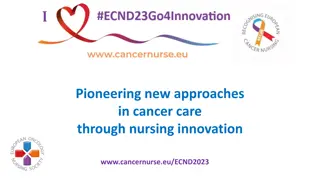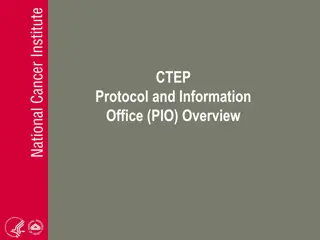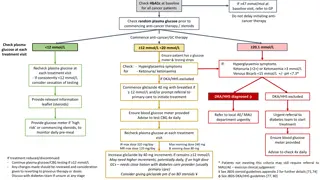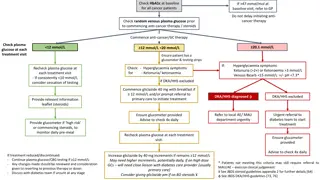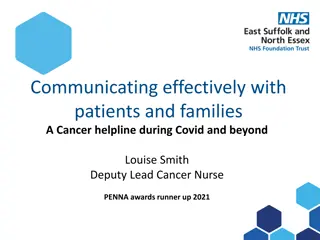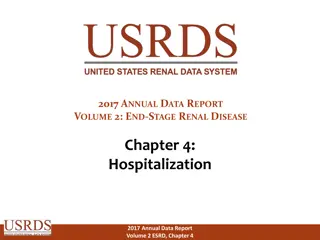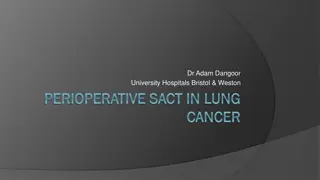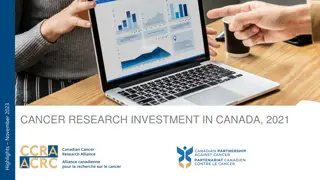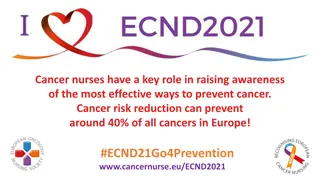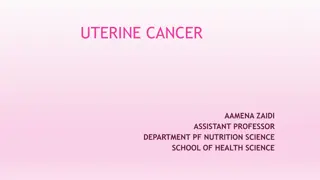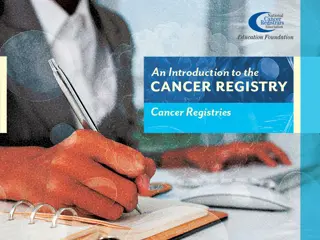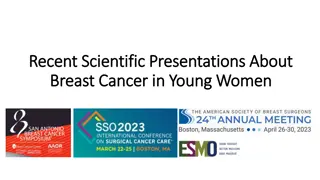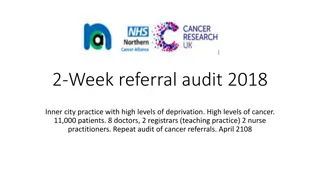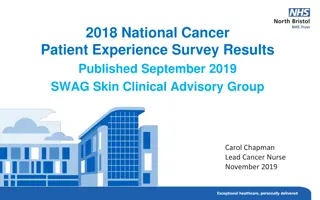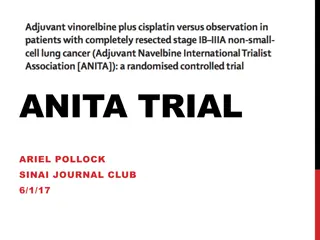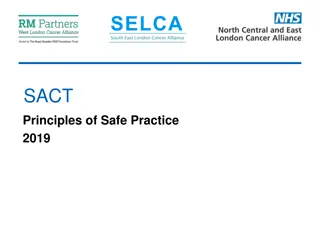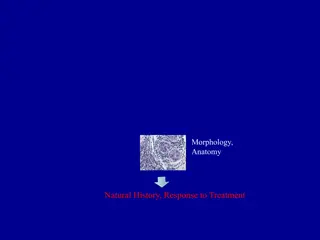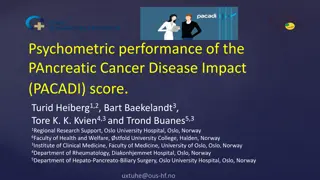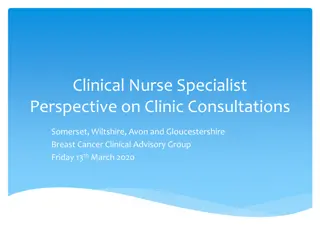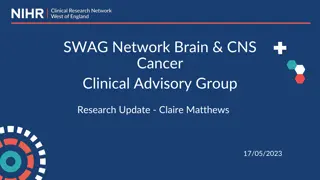Chemotherapy Utilization in End-Stage Gastrointestinal Cancer Patients
This presentation explores the prevalence, correlates, and outcomes of chemotherapy use in patients with end-stage gastrointestinal cancers. Data is presented on the frequency of chemotherapy administration, correlates, harms, and benefits in patients in their final months of life. Insights from studies conducted at various cancer centers shed light on the high proportion of patients receiving chemotherapy near death. The findings highlight the ongoing use of chemotherapy in patients with advanced gastrointestinal cancers, posing considerations for end-of-life care decision-making.
Download Presentation

Please find below an Image/Link to download the presentation.
The content on the website is provided AS IS for your information and personal use only. It may not be sold, licensed, or shared on other websites without obtaining consent from the author. Download presentation by click this link. If you encounter any issues during the download, it is possible that the publisher has removed the file from their server.
E N D
Presentation Transcript
Prevalence, Correlates, & Outcomes of Chemotherapy for Patients with End-Stage Gastrointestinal Cancers Holly G. Prigerson, PhD Renee C. Maciejewski, BS Manish A. Shah, MD Yuhua Bao, PhD Paul K. Maciejewski, PhD Center for Research on End-of-Life Care Weill Cornell Medicine
Learning Objectives After this presentation, participants should know the: prevalence patient profile outcomes associated with chemotherapy use for GI cancer patients who are nearing death Presented by: Holly G. Prigerson, Ph.D
Presentation Outline This talk will present data on the: a. frequency b. correlates c. harms & benefits of chemotherapy use in patients in their final months of life Presented by: Holly G. Prigerson, Ph.D.
Frequency of chemotherapy use in GI cancer patients near death Administration codes from SEER-Medicare data reveal that: Stage IV pancreatic cancer patients diagnosed 2006 2011 who died within a year of their diagnosis (total N=7998): 35% chemotherapy Stage IV pancreatic cancer patients diagnosed in 2011 and then died in 2012 (total N=1270): 37% chemotherapy Presented by: Holly G. Prigerson, PhD
Frequency of chemotherapy use in GI cancer patients near death From Coping with Cancer NCI R01 data: Sites: Yale Cancer Center, Dana-Farber/BWH, MGH, University of Texas Southwestern (Parkland, Simmons), Pomona Valley Hospital, New Hampshire Oncology Hematology, Weill Cornell/Meyer, University of New Mexico, Massey, Memorial Sloan-Kettering Cancer Centers Patients: GI cancer patients distant mets and refractory to at least 1 line of chemotherapy a median of 4 months from death CwC I (2002-2008): 50% patients using chemotherapy at baseline assessment Presented by: Holly G. Prigerson, Ph.D
From Coping with Cancer NCI R01 CwC II data (2010-2015): The question Are you currently receiving chemotherapy? The answer: pre-restaging scan = 90% receiving chemotherapy post-restaging scan = 81% receiving chemotherapy In the medical chart abstraction following restaging scan: 86% current chemotherapy use Across pre, post, and the med chart: 94%! receive chemotherapy Presented by: Holly G. Prigerson, Ph.D
Participants characteristics by chemotherapy at study enrollment Before propensity weighted adjustment Chemotherapy No (n=170) After propensity weighted adjustment All participants (n=386) Chemotherapy P- value P-value Yes (n=216) Yes (n=216) No (n=170) Age (yrs) 58.4 (12.5) 56.4 (12.3) 61.0 (12.5) <0.001 57.9 (11.9) 57.9 (12.2) >0.9 Male Married Insured 215 (56) 236 (61) 238 (62) 119 (55) 142 (66) 145 (67) 96 (56) 94 (55) 93 (55) 0.8 0.04 0.02 (55.8) (58.0) (55.9) (55.8) (58.0) (55.8) >0.9 0.8 0.8 Mean (SD) years of education 12.6 (4.0) 13.3 (3.9) 11.6 (4.0) <0.001 11.9 (4.1) 11.9 (4.2) >0.9 Race/ethnicity: White Black Hispanic Asian Religion: Catholic Protestant Jewish Muslim No religion Pentecostal Baptist 251 (65) 70 (18) 57 (15) 5 (1) 147 (68) 36 (17) 26 (12) 5 (2) 104 (61) 34 (20) 31 (18) 0 (0) (58.7) (22.1) (18.4) (0.7) (58.7) (22.1) (18.4) (0.0) Those getting chemo are: 0.1 0.7 younger married insured better educated 141 (36) 68 (18) 18 (5) 5 (1) 17 (4) 9 (2) 58 (15) 76 (35) 42 (19) 14 (6) 3 (1) 8 (4) 6 (3) 29 (13) 65 (38) 26 (15) 4 (2) 2 (1) 9 (5) 3 (2) 29 (17) (34.6) (16.0) (3.4) (0.7) (6.1) (3.7) (17.0) (34.6) (16.0) (3.4) (0.7) (5.0) (1.7) (19.5) 0.5 >0.9
Participants characteristics by chemotherapy at study enrollment Before propensity weighted adjustment All participants (n=386) Chemotherapy P value Yes (n=216) No (n=170) Mean (SD) performance status : Karnofsky score ECOG score Charlson Comorbidity Index Mean (SD) McGill Quality of Life : Physical functioning Symptoms Psychological: Depressed Worried Sad Terrified Support Sum score of quality of life 64.8 (16.2) 1.7 (0.9) 69.0 (14.8) 1.5 (0.9) 59.5 (16.4) 2.0 (0.9) <0.001 <0.001 Those getting chemo: 8.3 (2.7) 7.9 (2.3) 8.8 (3.0) 0.002 better performance status better QoL at baseline (when on chemo) 5.7 (2.6) 6.1 (2.4) 5.3 (2.9) 0.004 5.4 (2.1) 7.2 (2.5) 7.4 (2.9) 6.9 (3.2) 7.3 (3.0) 7.2 (3.1) 8.6 (1.6) 5.8 (2.0) 7.6 (2.4) 7.7 (2.7) 7.2 (3.0) 7.9 (2.7) 7.4 (2.8) 8.6 (1.7) 4.9 (2.1) 6.7 (2.6) 7.0 (3.2) 6.4 (3.3) 6.4 (3.2) 7.0 (3.4) 8.7 (1.6) <0.001 0.002 0.03 0.01 <0.001 0.2 0.9 6.8 (1.5) 7.0 (1.4) 6.6 (1.6) 0.002
Participants characteristics by chemotherapy at study enrollment Before propensity weighted adjustment All participants (n=386) Chemotherapy P value Yes (n=216) No (n=170) Institution: Yale Cancer Center 75 (19) 58 (27) 17 (10) Veterans Affairs CCC 19 (5) 8 (4) 11 (6) Parkland and Simmons Cancer Center MSKCC Dana-Farber and Massachusetts General New Hampshire Oncology Hematology Cancer: Lung Pancreatic Colorectal Other gastrointestinal Breast Other 188 (49) 106 (49) 82 (48) <0.001 28 (7) 26 (12) 2 (1) Those getting chemo are: > academic (MSKCC) < community (NHOH) cancer centers > GI cancers (75% pancreatic) 7 (2) 3 (1) 4 (2) 67 (17) 14 (6) 53 (31) 85 (22) 36 (9) 57 (15) 43 (20) 27 (13) 38 (18) 42 (25) 9 (5) 19 (11) 0.02 57 (15) 27 (13) 30 (18) 42 (11) 110 (29) 27 (13) 54 (25) 15 (9) 56 (33)
Participants characteristics by chemotherapy at study enrollment Before propensity weighted adjustment All participants (n=386) Chemotherapy P value Yes (n=216) No (n=170) Treatment preferences and planning: Wants prognostic information 269 (69) 152 (70) 117 (69) 0.8 Those getting chemo: want life- prolonging>comfort care Life extending care over comfort care 129 (31) 85 (37) 44 (24) 0.01 Chemotherapy to extend life by 1 week 288 (77) 186 (89) 102 (62) <0.001 want chemo even if prolongs life just a week Wants to avoid dying in ICU 161 (39) 76 (33) 85 (47) 0.1 Presented by: Holly G. Prigerson, Ph.D
Participants characteristics by chemotherapy at study enrollment Before propensity weighted adjustment All participants (n=386) Chemotherapy P value Yes (n=216) No (n=170) Completed living will or DPA 214 (55) 111 (51) 103 (61) 0.1 Those getting chemo: are less likely to complete a DNR order & acknowledge they re terminally ill Completed DNR order 161 (42) 77 (36) 84 (49) <0.05 Terminal illness acknowledgment 159 (40) 76 (35) 83 (47) 0.04 Patient-physician communication: Therapeutic alliance with physician Discussed end of life wishes with physician Coping style: Active Emotional Behavioral disengagement 244 (64) 131 (62) 113 (67) 0.3 are less likely to discuss EOL care preferences 162 (42) 80 (37) 82 (48) 0.03 177 (46) 190 (49) 105 (49) 106 (49) 72 (42) 84 (49) 0.3 >0.9 82 (21) 31 (14) 51 (30) <0.001 more engaged (less withdrawn) Mean (SD) positive religious coping 11.2 (6.4) 11.3 (6.3) 11.0 (6.5) 0.6 Presented by: Holly G. Prigerson, Ph.D
Outcomes of chemotherapy use Associations between chemotherapy at study enrollment and intensity of end of life care. Propensity weighted adjusted analysis Medical care in last week* Chemotherapy at enrollment Risk difference (95% CI) P value Yes No CPR, ventilation, or both 24 (12) 4 (2) 10.5 (5.0 to15.5) <0.001 Admission to intensive care unit 26 (13) 15 (8) 5.6 ( 0.5 to 11.7) 0.07 Chemotherapy 12 (6) 10 (5) 1.1 ( 3.6 to 5.7) 0.7 Feeding tube for enteral nutrition 22 (12) 9 (5) 7.1 (1.7 to 12.5) 0.01 Hospice 1 week 96 (52) 70 (38) 13.6 (3.6 to 23.6) 0.008
Outcomes of chemotherapy use Unadjusted analysis Propensity weighted adjusted analysis Chemotherapy at enrollment Chemotherapy at enrollment Risk Variable* difference (95% CI) Risk difference (95% CI) P value Yes (n=216) No (n=170) Yes No Place of death: Intensive care unit 8.8 (4.0 to 13.6) 24 (11) 4 (2) 19 (10) 7 (4) 6.1 (1.1 to 11.1) 0.02 9.8 (1.9 to 17.8) Hospital 54 (25) 26 (15) 38 (21) 32 (17) 3.6 ( 4.1 to 11.3) 0.4 18.4 ( 8.7 to 28.2) Home 102 (47) 112 (66) 100 (52) 122 (63) 10.8 ( 1.0 to 20.6) 0.03 Inpatient hospice 1.8 ( 4.7 to 8.4) 28 (13) 19 (11) 26 (13) 22 (12) 2.0 ( 4.6 to 8.7) 0.6 Nursing home 2.0 ( 6.2 to 2.1) Title of graphic 7 (3) 9 (5) 7 (4) 9 (5) 1.0 ( 5.0 to 3.1) 0.6 Death in preferred place 12.4 ( 3.6 to 21.2) 140 (65) 135 (80) 131 (68) 154 (80) 9.4 ( 0.8 to 18.1) 0.03 Presented by: Holly G. Prigerson, Ph.D
Patients Higher Quality of Life Near Death Stratified by Baseline Performance Status and Chemotherapy Use Prigerson et al. JAMA Oncol. 2015 ECOG indicates Eastern Cooperative Oncology Group. 69% 44% Performance status was measured by ECOG score as follows: 1. symptomatic, ambulatory 2. symptomatic, in bed less than 50% of the time 3. symptomatic, in bed more than 50% of the time
Conclusions Prevalence of chemotherapy in GI cancer patients within months of death is: frequent (~ 50%) nearly universal at academic medical centers becoming more common Presented by: Holly G. Prigerson, Ph.D
Conclusions GI cancer patients with progressive metastatic disease receiving chemo are more likely to be: younger married better educated > academic cancer clinics; < community cancer clinics Presented by: Holly G. Prigerson, Ph.D
Conclusions GI cancer patients with progressive metastatic disease who are receiving chemo are more likely than those who do not to: have better baseline performance status, QoL want life-prolonging care, including chemo even if only enhancing survival by a week lower rates of DNR order completion, terminal illness acknowledgment, & EoL discussions Presented by: Holly G. Prigerson, Ph.D
Conclusions GI cancer patients with progressive metastatic disease who get chemo are at risk in their last week of: CPR feeding tube ICU stay and death hospice stays of only a few days not dying at home or in preferred place of death Presented by: Holly G. Prigerson, Ph.D
Conclusions GI cancer patients near death who get chemo are likely to have: good performance status and, therefore, have the most to lose as they are: are more likely to have poor quality of death Presented by: Holly G. Prigerson, Ph.D
We appreciate this opportunity to present at ASCO 2016 GI Cancers Symposium! Thank You! Presented by: Holly G. Prigerson, Ph.D
Chemotherapy Use, Performance Status, & Quality of Life at the End of Life Prigerson et al. JAMA Oncology 2015
